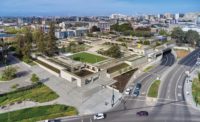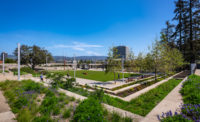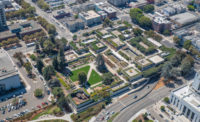Oakland, California
In 1968, the year before the Oakland Museum opened, New York Times architecture critic Ada Louise Huxtable wrote: “In terms of architecture and environment, Oakland may be the most thoughtfully revolutionary museum in the world.” Remarkably forward-thinking in its integration of planted and insulating roof terraces, the three-tiered, exposed-concrete structure seemed to grow organically from the park around it. Dedicated to California’s art, history, and natural sciences, the building’s three main levels were designed to step down a slope, with a veritable Gardens of Babylon cascading over the roof decks.
Here, in a city with significant poverty, was an admission-free “museum for the people,” envisioned as a porous building with multiple casual entrances and exits instead of a grand front portal. Museum and park — the collaboration of architects Kevin Roche John Dinkeloo and Associates with landscape architect Dan Kiley — flowed together as a continuous public space, spanning the equivalent of five city blocks.
Although locals embraced the institution, and it gained a following among design aficionados, the unassuming rather than iconic architecture — hunkering down and semicamouflaged by design — never transformed downtown Oakland with the tourist-attracting force of a Guggenheim Bilbao. And once the museum began charging admission in 1996, a controlled main entrance became a necessity, undercutting the original premise of free flow and making it tricky for people to figure out exactly where to enter. With admissions lines snaking down the building’s outdoor passageway came such challenges as protecting visitors from glaring sun or pouring rain. So the museum inserted a stopgap canvas canopy, awkwardly descending the entry-route steps. Meanwhile, inside, consistently low, 11.6-foot ceilings, coupled with the original unrelenting 20-foot bays (expressed as a series of “Brutalist” exposed-concrete walls), were encroaching on curatorial freedom.
Program
Clarifying the experience of arrival while introducing shelter from the elements and ADA access was essential. Although the $62.2 million addition and renovation would increase the 150,000-square-foot museum by only 5,800 square feet, it still needed to render the galleries more flexible and varied, especially in height, proportion, levels of intimacy, quality of light, adjacencies, and overall circulation. The building’s aging and inadequate infrastructure also required upgrades.
Solution
The obvious architect for the expansion might have been Kevin Roche, but after much back and forth, the museum hired Mark Cavagnero Associates, which had devised the institution’s master plan in 1999. (After working closely with Edward Larrabee Barnes in New York, Mark Cavagnero partnered with Barnes’s son in San Francisco before taking over the firm there in 1993.) The challenge here was complicated by the building’s landmark status. In the end, Cavagnero’s approach emerged as possibly more Roche than Roche — or, at least, more in keeping with the 1960s design. Where the original architect now proposed encasing his entry sequence of outdoor walkways and courts in glass, Cavagnero looked for quasi-surgical ways of stitching in outdoor shelter.
“I have always loved this building. Along with the Ford Foundation, it’s one of Roche’s best,” says Cavagnero. He sees his strategy as “a foil to the powerful existing concrete structure,” playing lighter planes and frames delicately against the concrete. Most prominent is the canopy he cantilevered over the entry sequence — a continuous 90-foot-long folded plane, clad in softly reflective, almost matte, stainless steel. The silvery metal quietly echoes the gray concrete, rather than literally mimicking it — while unmistakably defining the entrance.
Inside, L-shaped insertions of white or solid-colored walls provide smooth, bright backdrops for the collections and modulate the 20-foot bays with spaces of varied size and proportion. Two new, clerestory-lit end galleries (accounting for most of the added square footage) invite flow through the exhibition areas, eliminating original culs-de-sac. Cavagnero restored long-lost sectional openings and unblocked original windows, bringing daylight back into galleries without excessive glare or heat gain. The team also reconfigured programmatic adjacencies and lighting, plus integrated modern building systems, which are shoehorned into existing cast-concrete channels. With 20-foot-high end galleries, the museum can finally display all of its Richard Diebenkorn paintings and other tall artworks.
Commentary
The conundrum of expanding on significant architecture can prompt extreme strategies: from dramatic counterpoint to stylistic pastiche. Cavagnero’s respectful intervention is neither. Though always distinct from the original, the changes are deftly woven in, at times almost imperceptibly. The nature of the original building — more fabric than object — and the addition’s relative smallness invited a light hand, and, to a great extent, landmark protection required it (even clipping back the longer, more dynamic canopy Cavagnero proposed). The result is a museum true to its original spirit, with newfound functionality. Yet the intervention is so thoughtfully understated it sometimes makes you hunger for at least a momentary jolt of revolution.
Total construction cost: $17 million
Gross square footage: 94,000 sq.ft.
Completion date: May 2010
Architect:
Mark Cavagnero Associates
1045 Sansome Street, Suite 200
San Francisco, CA 94111
Tel: 415-398-6944
Fax: 415-398-6943
People
Owner
Architect:
Personnel in architect's firm who should receive special credit:
Engineer(s):
Structural Engineer:
Mechanical/Plumbing Engineer:
Electrical Engineer:
Consultant(s)
Lighting:
Acoustical:
Other:
Project Management:
Project Management:
General contractor:
Photographer(s):
CAD system, project management, or other software used: |
Products
Structural system Manufacturer of any structural components unique to this project: Eandi Metal Works
Exterior cladding Structural glass windows and skylights: Innovative Structural Glass
Roofing
Glazing
Insulated-panel or plastic glazing:
Hardware
Interior finishes Acoustic plaster ceilings: Baswaphon
Cabinetwork and custom woodwork:
Paneling / shelving system at retail store:;
Special surfacing: Gallery carpet: Monterey carpets, A Tandus Company Retail Carpet: Bentley Prince Street
Special interior finishes unique to this project:
Lighting Canopy and exterior lighting: Se’Lux |
















Post a comment to this article
Report Abusive Comment